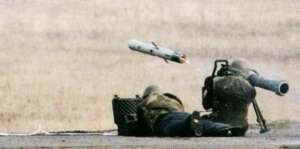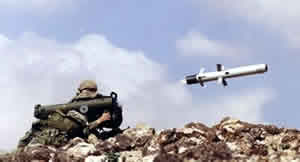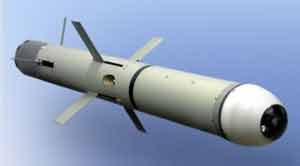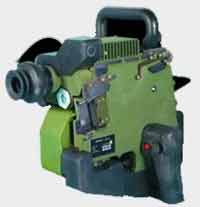| Designation: | Spike-LR |
 |
|---|---|---|
| Manufacturer: | RAFAEL Armament Development Authority Ltd. | |
| Product type: | Weapons & Weapon Systems | |
| Name: | Anti-tank guided missile launcher |
Rafael based in Haifa, Israel, manufacture the Spike family of anti-armour weapons. The weapons are lightweight fire-and-forget anti-tank missiles and use electro-optical and fibre-optic technologies. The systems are used by infantry soldiers, special rapid reaction forces, ground forces and helicopter aircrew.
The Spike family includes the Gill and the Spike missiles and is currently in production and in service with the Israeli Defence Force and with the Singapore Armed Forces. In November 1998, Rafael signed a co-operation agreement with EuroSpike (STN ATLAS, Diehl and Rheinmetall) to market, produce, sell and maintain Rafael's anti-armour systems, including the Gill and the Spike in certain European markets. Rafael have also signed an agreement with MBDA (formerly Matra BAe Dynamics) to address the British and some other European and overseas markets.
In May 2000, the Finnish Army selected a version of the Spike system, Spike 2.5, to meet its requirement for a medium-range anti-tank missile system. STN Atlas will produce the launchers, Diehl the munition and Rheinmetall the warhead.
In August 2001, the Netherlands Ministry of Defence ordered the Gill missile system to replace the Dragon missile of the RNl Army and Marine Corps. Rafael is the prime contractor, with STN Atlas, Diehl and Thales Nederland (formerly Signaal) the major subcontractors.
The UK Defence Procurement Agency has purchased a number of Spike missile systems for trials and has issued an Invitation to Tender (ITT) to MBDA and to Javelin Joint Venture for the Javelin system, for the Light Forces Anti-Tank Guided Weapon System (LFATGWS) requirement. A decision on selection is expected in 2002.
In July 2002, Poland selected the missile system with deliveries planned to begin in 2003. Local production by ZM Mesko is expected to form part of the contract terms.
The Gill and the Spike have the same firing post. The firing post consists of the Command Launch Unit (CLU), the thermal imager and a tripod. The Gill, the shorter range version, is a portable fire and forget anti-armour missile system with a range up to 2.5 kilometres. The Gill uses a charge coupled device (CCD) seeker for day time use or an imaging infrared (IIR) seeker for day and nightime use. Gill can fly with a lofted trajectory enabling the tandem warhead to hit the target at the most vulnerable point. Spike is a portable anti-armour weapon system with a range up to 4 kilometres, which can be operated in fire-and-forget mode and in fire, observe and update mode for non-line-of-sight (NLOS) operations using the fibre optic data link. One soldier can carry two missiles in the back pack and the total system weight is 26 kg.
The system is made ready to fire in less than 30 seconds. The soldier acquires the target and lays the cross hairs of the sight on the aim point on the target using either the day sight with a 10 times magnification and 5 degree field of view or the clip-on thermal imaging night sight with wide and narrow fields of view.
The soldier activates the missile, locking the tracker on the target and he pushes the Fire button to launch the missile. The missile automatically propels itself towards the target without any additional interaction and this fire and forget capability allows the soldier the option of relocating to a new firing position or to reload immediately for the next engagement. Reloading takes less than 15 seconds.
After launch the missile follows a lofted trajectory and as it approaches the target it dives down to impact the target. The lofted trajectory and the tandem high explosive warhead enables the missile to penetrate tanks equipped with explosive reactive armour (ERA).
The missile has four rectangular fins for aerodynamic control at the rear, and four wings at just over halfway from nose to tail on the length of the body. They unfold as the missile leaves the launch cannister.
The guidance system in the nose of the Gill-Spike missile comprises a charge coupled device (CCD) and Imaging Infra-Red (IIR) seeker. The imaging infrared provides higher sensitivity and improved thermal background rejection characteristics for all weather day and night operation. Gill has a range up to 2,500 metres.
The Gill-Spike training programme includes target identification and acquisition, missile lock-on and post launch observation. The Gill-Spike system has two simulators for individual training. The Outdoor Simulator trains soldiers, using real targets, up to the point of missile launch. The Indoor Trainer also trains soldiers up to the point of missile launch and during missile flight using the fibre optic data link
The SPIKE Family consists of missiles suited for several platforms, multiple ranges and a variety of targets. The missiles in this family have sophisticated electro-optic CCD or IR sensors for operation day and night and in adverse weather conditions and a tandem warhead. Their lofted trajectories enable the warhead to hit the target at its most vulnerable part with pinpoint precision. All of the SPIKE Family members have a low Life Cycle Cost, due to high reliability and operational, logistic support and production commonality between members.
The SPIKE-LR is a lightweight, Fire and Forget and Fire, Observe and Update, multi-purpose missile system with a range of up to 4,000 meters. State-of-the-art seeker and fiber-optic data communication link provide SPIKE-LR with the unique ability to:
- Update or switch targets after launch
- Achieve real-time intelligence and identify friend or foe
- Perform battle damage assessment
- Achieve extended range and pinpoint accuracy
- Minimize collateral damage
|
||||||||
|
|||||||||||||||||||||||||||||||||||||||||||||||||||||||||||||||||||||
|
||||||||||||||||||||
All contracts...
Related Articles |
|
BAE Systems` CV90 increases lethality by testing SPIKE LR anti-tank guided missile (14.01.2020) |
|
General Dynamics Awarded $425M for Missile Systems by Spanish Army (12.01.2007) |
|
PANDUR II 8x8 WITH RAFAEL RCWS 30 (20.01.2006) |
 |
 |
 |
 |


















